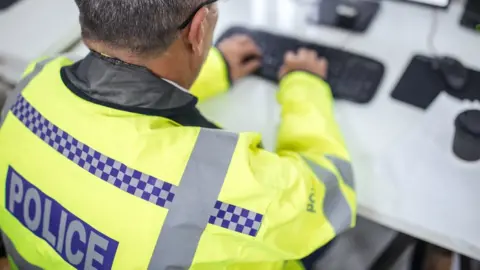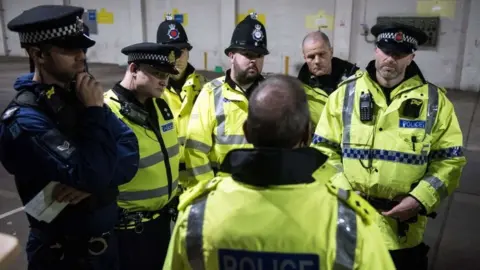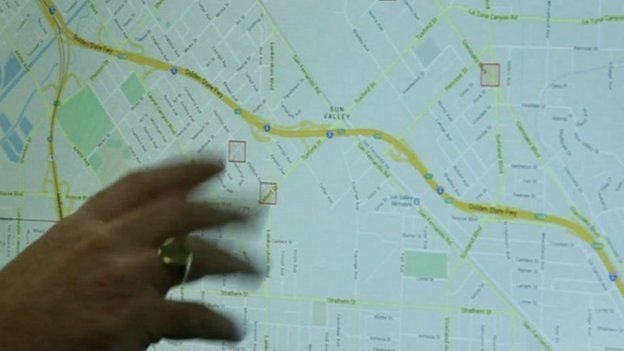Crime prediction software 'adopted by 14 UK police forces'
 Getty Images
Getty ImagesAt least 14 UK police forces have made use of crime-prediction software or plan to do so, according to Liberty.
The human rights group said it had sent a total of 90 Freedom of Information requests out last year to discover which forces used the technology.
It believes the programs involved can lead to biased policing strategies that unfairly focus on ethnic minorities and lower-income communities.
And it said there had been a "severe lack of transparency" about the matter.
Defenders of the technology say it can provide new insights into gun and knife crime, sex trafficking and other potentially life-threatening offences at a time when police budgets are under pressure.
One of the named forces - Avon and Somerset Police - said it had invited members of the press in to see the Qlik system it used in action, to raise public awareness.
"We make every effort to prevent bias in data models," said a spokeswoman.
"For this reason the data... does not include ethnicity, gender, address location or demographics."
But Liberty said the technologies lacked proper oversight, and moreover there was no clear evidence that they had led to safer communities.
"These opaque computer programs use algorithms to analyse hordes of biased police data, identifying patterns and embedding an approach to policing which relies on discriminatory profiling," its report said.
"[They] entrench pre-existing inequalities while being disguised as cost-effective innovations."
Predictive software
Liberty's report focuses on two types of software, which are sometimes used side-by-side.
The first is "predictive mapping", in which crime "hotspots" are mapped out, leading to more patrols in the area.
The second is called "individual risk assessment", which attempts to predict how likely an individual is to commit an offence or be a victim of a crime.
 Getty Images
Getty ImagesThe report says the following forces had already used one or both types or were planning to do so:
- Avon and Somerset
- Cheshire
- Durham
- Dyfed Powys
- Greater Manchester
- Kent
- Lancashire
- Merseyside
- The Met
- Norfolk
- Northamptonshire
- Warwickshire and West Mercia
- West Midlands
- West Yorkshire
Companies that develop such applications include IBM, Microsoft, Predpol and Palantir and there are efforts to create bespoke solutions.
Risk scores
The BBC contacted each of the named forces and two responded that they had already stopped using the technology.
Cheshire Police said it had trialled a mapping program between January and November 2015 but had since stopped using the system.
And Kent Police confirmed it had introduced a predictive policing mapping tool in 2013 but had subsequently decided not to renew its contract, as reported last year.

"The launch of a new policing model that places victims and witnesses at its centre has led Kent Police to evaluate alternative options which will support a focus on both traditional and emerging crime types," a spokeswoman said.
Several forces, however, are involved in a £4.5m "proof-of-concept project", called the National Data Analytics Solution (NDAS), which is funded by the Home Office.
It draws on information already held by the police about roughly five million people, including incident logs, custody records and conviction histories.
Using machine-learning techniques, the aim is to calculate a risk score for individuals as to their likelihood of committing crimes in the future.
In addition, the police hope to use the system to identify which members of their own workforce need support to help reduce illness.
West Midlands Police leads the effort. The others involved include Metropolitan Police, Greater Manchester Police, Merseyside Police, West Yorkshire Police, Warwickshire and West Mercia Police.
"We want to see analytics being used to justify investment in social mobility in this time of harmful austerity, addressing deep-rooted inequalities and helping to prevent crime," said Tom McNeil, strategic adviser to the effort.
"To support this we have appointed a diverse ethics panel placing human rights at the centre."
However, a report by the Alan Turing Institute - which was commissioned by the police - raised concerns that those involved had been too vague about how they planned to address the risks involved.
